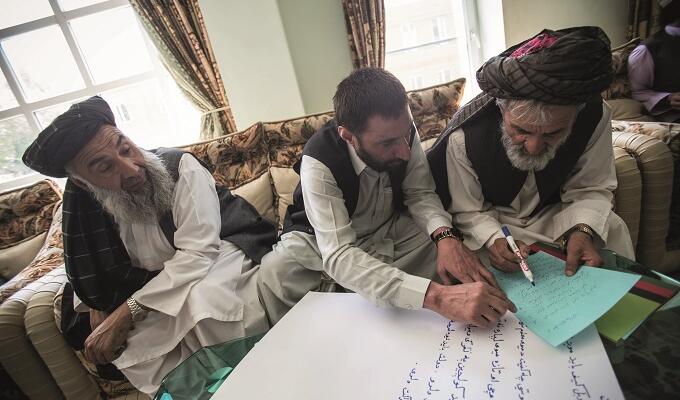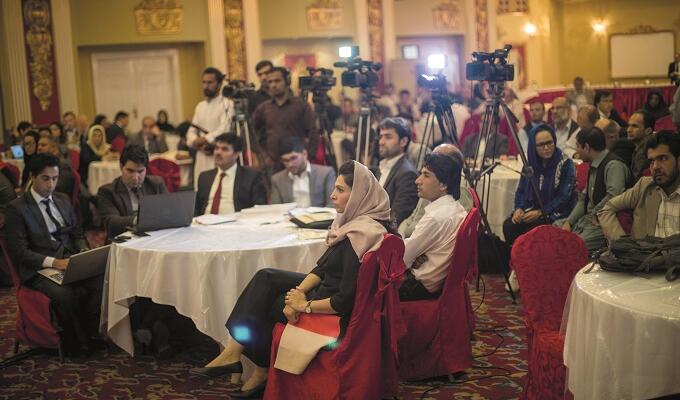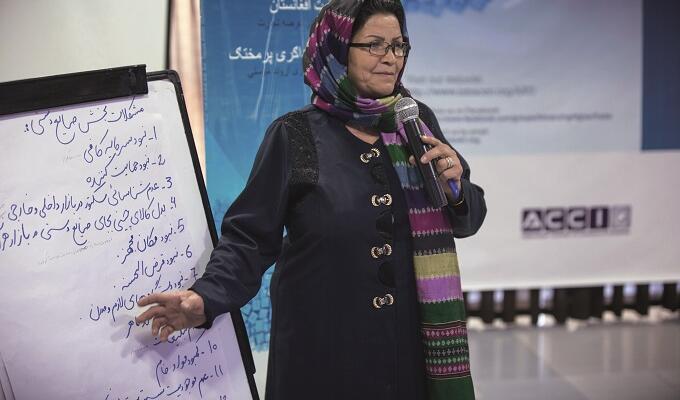


Historias
Laying the policy groundwork to advance Afghan trade (en)
28 junio 2019
The challenge
Like many post-conflict states, Afghanistan views economic growth, job creation and social stability as deeply intertwined. Increased trade in goods and services could make an important contribution to the country’s economy and the livelihoods of its citizens.
Expanding Afghanistan’s trade ties has been a priority for President Ashraf Ghani’s government since it took office in September 2014. The landlocked country acceded to the World Trade Organization (WTO) in 2016, giving it predictable access terms to most of the world’s economies. Kabul has also sought to establish trade routes to its key markets. The government has signed transit agreements with Turkmenistan, Azerbaijan and Georgia as part of a proposed land and sea trade route to Europe, dubbed the Lapis Lazuli Corridor. It has inked trade and transit agreements with neighbouring Uzbekistan and Tajikistan, improving access to China and the Russian Federation. Trade with India has begun to flow via Iran’s Chabahar Port and the Afghanistan-India Air Corridor, which since June 2017 has provided subsidized air transport for cargo departing from Kabul and Kandahar for Delhi and Amritsar.
Yet improved market access and transportation links will not suffice to revive Afghan trade at scale. Decades of conflict have exacted a toll upon the country’s labour force, disrupted its historic trade patterns and left its businesses with limited knowledge of international markets. Would-be exporters must overcome security instability, crumbling infrastructure, a poor business environment and high trading costs.
Even budding success stories, such as the Afghan saffron sector, have had shipments barred from some European markets due to contamination that exceeded regulatory health and safety limits. Afghan dried fruits, particularly raisins, have met a similar fate due to substandard processing and storage.
For the Afghan private sector to compete in international markets, increased firm-level capacity – for instance, to meet market requirements – will need to go hand-in-hand with a more supportive policy and institutional environment. This combination is especially important for the micro, small and medium-sized enterprises (MSMEs) that account for the lion’s share of jobs in Afghanistan.
The response
Building on its support for Afghanistan’s WTO accession process, ITC has been working with the Afghan Ministry of Industry and Commerce, the Afghanistan Chamber of Commerce and Industries (ACCI) and the Afghanistan Women Chamber of Commerce and Industry (AWCCI) to enable Afghan MSMEs to participate in international trade and reap the benefits of regional economic integration.
The primary goal of the Advancing Afghan Trade initiative, launched in November 2016, is to enhance national capacities to design and implement policy reforms and institutional investments to improve the policy environment and support infrastructure for MSMEs to trade.
ITC and its partners first worked to develop two overarching policy reform papers – a National Export Strategy and a National Trade Policy – that would establish the overall policy framework for the country’s efforts to increase output and trade in sectors with high potential to generate exports and jobs.
To shape the content of these documents, the project partners actively sought to include views from Afghanistan’s private sector, which had long felt marginalized in the country’s trade policy process. The ACCI organized consultations with business leaders and investors in Kabul, Mazar-e-Sharif, Herat and Kandahar, ultimately meeting with over 500 Afghan small business owners and industry leaders who collectively shaped the consensus on the main issues impeding Afghanistan’s trade competitiveness.
The results
The National Export Strategy (NES) identifies sectors with high potential for exports and job creation, particularly for women and young people. For each of these sectors – carpets, dried fruits and nuts, fresh fruits and vegetables, saffron, marble and granite, precious stones and jewellery – it proposes measures to overcome weaknesses currently weighing on international competitiveness. For instance, the strategy calls for organizing or strengthening farmers’ associations to overcome fragmentation, foster economies of scale and facilitate the delivery of technical assistance in the saffron sector. The carpet sector, meanwhile, would benefit from better branding, simpler customs procedures, and more support – such as trade attachés – within foreign markets.
The strategy also identifies how to remedy key cross-cutting factors impeding Afghan exports. Establishing mechanisms to provide trade- and market-related information, and strengthening trade and investment support institutions would for example help MSMEs better understand demand trends and make connections in unfamiliar markets.
The National Export Strategy was presented to the Afghan Council of Ministers and the country’s Executive Committee of Private Sector Priorities in November 2017. This was an essential last step prior to final endorsement by the country’s High Economic Council, presided over by President Ghani.
Afghanistan’s National Trade Policy was also developed over the course of 2017 and finalized early the following year. The paper examines factors inhibiting Afghan trade and proposes solutions. For instance, to balance revenue generation and industrial development needs, it calls for rationalizing the country’s tariff regime, currently marked by a haphazard and unevenly applied regime of duty exemptions. It also recommends simplifying border procedures and documentation requirements.
For the Afghan private sector, the consultative process that informed the two documents has been almost therapeutic.
‘We were treated as a teammate of the government in this process, not a competitor,’ said ACCI chief executive Atiqullah Nusrat.
Afghan Minister of Industry and Commerce Humayoon Rasaw said the documents would promote ‘a balanced relationship between trade integration and sustainable domestic economic development.’
The future
Following the official endorsement of the NES, ITC and its partners will organize a donor round table to seek coordination and support for implementing the measures in the strategy. ITC will provide technical and advisory support to the Afghan government on issues including trade facilitation and modernizing the country’s health and safety regulations, as well as on building competiveness in the saffron sector.
Like the NES, the National Trade Policy will first be presented to the Council of Ministers and then go to the High Economic Council for approval.
Like many post-conflict states, Afghanistan views economic growth, job creation and social stability as deeply intertwined. Increased trade in goods and services could make an important contribution to the country’s economy and the livelihoods of its citizens.
Expanding Afghanistan’s trade ties has been a priority for President Ashraf Ghani’s government since it took office in September 2014. The landlocked country acceded to the World Trade Organization (WTO) in 2016, giving it predictable access terms to most of the world’s economies. Kabul has also sought to establish trade routes to its key markets. The government has signed transit agreements with Turkmenistan, Azerbaijan and Georgia as part of a proposed land and sea trade route to Europe, dubbed the Lapis Lazuli Corridor. It has inked trade and transit agreements with neighbouring Uzbekistan and Tajikistan, improving access to China and the Russian Federation. Trade with India has begun to flow via Iran’s Chabahar Port and the Afghanistan-India Air Corridor, which since June 2017 has provided subsidized air transport for cargo departing from Kabul and Kandahar for Delhi and Amritsar.
Yet improved market access and transportation links will not suffice to revive Afghan trade at scale. Decades of conflict have exacted a toll upon the country’s labour force, disrupted its historic trade patterns and left its businesses with limited knowledge of international markets. Would-be exporters must overcome security instability, crumbling infrastructure, a poor business environment and high trading costs.
Even budding success stories, such as the Afghan saffron sector, have had shipments barred from some European markets due to contamination that exceeded regulatory health and safety limits. Afghan dried fruits, particularly raisins, have met a similar fate due to substandard processing and storage.
For the Afghan private sector to compete in international markets, increased firm-level capacity – for instance, to meet market requirements – will need to go hand-in-hand with a more supportive policy and institutional environment. This combination is especially important for the micro, small and medium-sized enterprises (MSMEs) that account for the lion’s share of jobs in Afghanistan.
The response
Building on its support for Afghanistan’s WTO accession process, ITC has been working with the Afghan Ministry of Industry and Commerce, the Afghanistan Chamber of Commerce and Industries (ACCI) and the Afghanistan Women Chamber of Commerce and Industry (AWCCI) to enable Afghan MSMEs to participate in international trade and reap the benefits of regional economic integration.
The primary goal of the Advancing Afghan Trade initiative, launched in November 2016, is to enhance national capacities to design and implement policy reforms and institutional investments to improve the policy environment and support infrastructure for MSMEs to trade.
ITC and its partners first worked to develop two overarching policy reform papers – a National Export Strategy and a National Trade Policy – that would establish the overall policy framework for the country’s efforts to increase output and trade in sectors with high potential to generate exports and jobs.
To shape the content of these documents, the project partners actively sought to include views from Afghanistan’s private sector, which had long felt marginalized in the country’s trade policy process. The ACCI organized consultations with business leaders and investors in Kabul, Mazar-e-Sharif, Herat and Kandahar, ultimately meeting with over 500 Afghan small business owners and industry leaders who collectively shaped the consensus on the main issues impeding Afghanistan’s trade competitiveness.
The results
The National Export Strategy (NES) identifies sectors with high potential for exports and job creation, particularly for women and young people. For each of these sectors – carpets, dried fruits and nuts, fresh fruits and vegetables, saffron, marble and granite, precious stones and jewellery – it proposes measures to overcome weaknesses currently weighing on international competitiveness. For instance, the strategy calls for organizing or strengthening farmers’ associations to overcome fragmentation, foster economies of scale and facilitate the delivery of technical assistance in the saffron sector. The carpet sector, meanwhile, would benefit from better branding, simpler customs procedures, and more support – such as trade attachés – within foreign markets.
The strategy also identifies how to remedy key cross-cutting factors impeding Afghan exports. Establishing mechanisms to provide trade- and market-related information, and strengthening trade and investment support institutions would for example help MSMEs better understand demand trends and make connections in unfamiliar markets.
The National Export Strategy was presented to the Afghan Council of Ministers and the country’s Executive Committee of Private Sector Priorities in November 2017. This was an essential last step prior to final endorsement by the country’s High Economic Council, presided over by President Ghani.
Afghanistan’s National Trade Policy was also developed over the course of 2017 and finalized early the following year. The paper examines factors inhibiting Afghan trade and proposes solutions. For instance, to balance revenue generation and industrial development needs, it calls for rationalizing the country’s tariff regime, currently marked by a haphazard and unevenly applied regime of duty exemptions. It also recommends simplifying border procedures and documentation requirements.
For the Afghan private sector, the consultative process that informed the two documents has been almost therapeutic.
‘We were treated as a teammate of the government in this process, not a competitor,’ said ACCI chief executive Atiqullah Nusrat.
Afghan Minister of Industry and Commerce Humayoon Rasaw said the documents would promote ‘a balanced relationship between trade integration and sustainable domestic economic development.’
The future
Following the official endorsement of the NES, ITC and its partners will organize a donor round table to seek coordination and support for implementing the measures in the strategy. ITC will provide technical and advisory support to the Afghan government on issues including trade facilitation and modernizing the country’s health and safety regulations, as well as on building competiveness in the saffron sector.
Like the NES, the National Trade Policy will first be presented to the Council of Ministers and then go to the High Economic Council for approval.




